GROWTH
Refers to the irreversible (permanent) increase in size and mass of an organism.
– Reproduction results in the formation of new organisms. Every newly produced organism is usually small in size, with time the organism increase in size and weight.
– In multicellular organisms the increase in size and weight is a result of the increase in the number and size of body cells. As the number of cells increases various organs are formed.
– The changes can take place only if energy and raw materials are available. The energy and raw materials are derived from food. Because raw materials are used, growth brings about an increase in the mass of an organism.
– In some multicellular organisms as new cells are formed some old cells usually die off. In such cases there is therefore a continuous addition and less of cells. But for growth to occur the rate of cell increase must exceed the rate of cell less.
– When the rate of cell increase is higher than the rate of cell less growth is referred to as POSITIVE GROWTH.
– When the rate of cell increase is lower than the rate at which cells are lost from the body, the organism decrease in size and weight. This is also growth and it is referred to as NEGATIVE GROWTH. It may be caused by an illness or starvation.
– It should be noted however that negative growth cannot go on indefinitely. An organism cannot resume the size , weight and body shape of a newly born body. For this reason growth is said to be irreversible.
IMPORTANCE OF GROWTH IN LIVING THINGS
i. Life usually starts as a single cell e.g a human zygote (fertilized egg) give rise to billions of different cells etc.
ii. During growth and development the cells divide and enlarge giving rise to a more complex and elaborate multicellular organism.
iii. Growth give rise to various cells specialized in various specific functions.
Examples; – Red blood cells carry oxygen
– White blood cells fight pathogens
– Palesade cells carry out Photosynthesis
– Guard cells close and open stomata etc.
iv. This specialization brings about effectiveness and organisms are therefore able to adapt different environments.
v. During growth sexual organism in mamals develop with fully developed sex organs, an organism is capable of reproduction and hence perpetuation of the species.
DEVELOPMENT.
Refers to the changes in the complexity of an organism. It involves differentiation and formation of various tissues that perform specialized functions.
Note: Growth is brought about by;-
i. Cell division
ii. Cell enlargement
iii. Cell differentiation
TYPES OF GROWTH
i. Diffuse Growth
This is the type of growth whereby growth occurs all over the body of an organism e.g in animals.
ii. Localized Growth
This is the type of growth whereby growth occurs in certain regions, e.g in plants growth takes place at the tips of roots and shoots, These tips are called meristems.
iii. Intermittent Growth
This is a type of growth in arthropods in which growth takes place in a series of stages called instars. E.g in insects an egg hatches into a larva which then develops into a pupa and finally into an adult (image).
iv. Isometric Growth
This is the type of growth whereby all body organs grow at the same rate e.g in fish, locust.
THE GROWTH CURVE
Growth can be measured using a curve. A growth curve is a graph obtained when data collected during stages of growth is plotted against the time.
– A growth curve shows growth pattern of the organism. In most organisms growth pattern is almost the same where by first shows slow then speeds up and finally slows down.
– This pattern gives an S-shaped curve known as sigmoid curve.
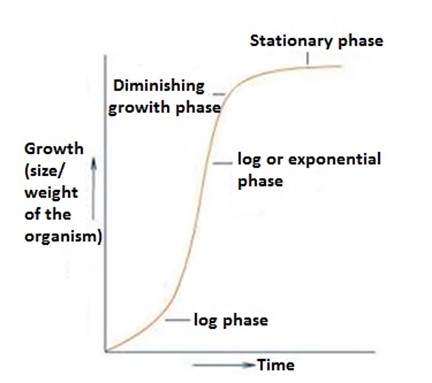
Lag phase
Lag phase is a period when the rate of growth is very slow, during the stage the number of cell dividing through mitosis are few
Log phase /exponential phase
This phase involves very rapid growth where by the number of cell division is higher than the dead cells.
Linear growth /declaration phase.
This phase involves the decline in the rate of growth as maturity is approached the rate of cell division decrease.
Stationary phase/plateau phase
This phase marks the period of no further changes in the size of the organism the organism has attained maturity, new cells are formed only to replace those worn out or dead cells.
MEASUREMENT OF GROWTH
Growth can be estimated by measuring any suitable parameter of an organism at suitable intervals of time. Some of the common parameter measured include, Length, Width, Area, Fresh mas and Mass of an organism.
(i) Length
– This method is reliable if growth occurs mainly in one direction.
– Increase in length denotes growth. In plants for example leaves, stem and internodes on stems can be measured.
Advantages
i. The change in length is easy to work out.
ii. The same organism is used throughout the investigation.
iii. The organism are not harmed.
Disadvantages
i. It ignores growth in other directions such as width and girth, which can be significant.
(ii) Total fresh weight (mass)
– This method involves weighing the whole organism at regular intervals.
– This is an easy method used to estimate growth in large animals including man.
Advantages
i. Weighing is easy
ii. It does not involve injury to the organism.
Disadvantages
i. Fresh weight measurement method are influenced changes in water content of the body and therefore do not always give accurate results.
(iii) Dry mass (Weight)
– Is used to measure growth of small oranisms such as germinating wheat.
– It involves killing the organism and heating it at 1100c to a constant weight to remove water.
– This method is more accurate since it indicates the increase in weight due to synthesis of different materials irrespective of water content.
Disadvantages
i. The method involves killing the organisms and thus has limited usage.
ii. A large number of organisms are used, hence the method is wasteful.
(iv) Width
– The width of parts of an organism can be measured over a period of time.
Advantages
i. Width is easily measured
ii. The same organism is used to monitor growth.
Disadvantages
i. Increase in width interpreted as the only aspect of growth occurring.
INTERNAL FACTORS THAT REGULATE GROWTH IN PLANTS.
1) Heredity factors.
– These are internal factors that affect the growth of plants. They affect the physical appearance and the size of a plant.
– Hereditary units called genes are found in chromosomes inside the nucleus of all plant cells. These units control the various characteristics of plants such as flower colour, number of floral parts, growth pattern and so on.
– Genes are passed from parents to offspring. For example tall plants produce tall offspring and vice-versa.
2) Growth hormones.
– Hormones are chemical substances that influence physiological processes. Growth hormones affect growth which is brought about by cell division and enlargement.
– Plant hormones called auxins promotes growth in plants.
– Examples of plant hormones are, Indole Acetic Acid (IAA), Gibberellins, Cytokinins, Ethylene (ethene), Abscisic acid (ABA), Indolebutyric acid.
3) Apical dominance
– Is the inhibition of the growth of lateral buds by the presence of the growing apical bud.
– Apical bud is found at the top of the plant which is responsible for increase in plants height (Apical growth).
– Lateral buds are found on the sides of the plant which are responsible for the formation of branches.
– The apical bud produces suxins that diffuse to the lower parts of the plant. These auxin retord the development of lateral buds. The lateral branches of such a plant are short.
EXTERNAL FACTORS AFFECTING GROWTH IN PLANTS.
These are also called environmental factors, they include the following;
1) Plant nutrition
– There are several plant nutrients which are needed for better growth of plants.
– The basic nutrients required for plant growth are divided into two main categories namely micro-nutrients and macro-nutrients.
i. Macro-nutrients
Are nutrients that are required by plants in larger quantities. There are six elements in the soil that are termed as macro-nutrients. These are,
– Nitrogen
– Potassium
– Magnesium
– Calcium
– Phosphorous, and
– Sulphur.
ii. Micro-nutrients
Are nutrients that are required by plants in smaller quantities.There are eight elements in the soil that are termed as micro-nutrients.These are,
– Iron
– Zinc
– Molybdenum
– Manganese
– Boron
– Copper
– Cobalt, and
– Chlorine.
– Nitrate for instance are an important component for synthesis of proteins. Proteins are needed for plant growth. Absence of nitrate cause plant to look shorter than their real age (stunning).
2) Water
– Water is one of the most essential factors required in growth of plants. It plays a crucial role for efficient photosynthesis, respiration, transportation and transpiration of minerals and other nutrient through the plant.
– Water is also responsible for proper functioning of the stomata opening leaves.
3) Light
– Light is necessary for photosynthesis to take place. Plants make their own food through the process of photosynthesis. Food is necessary for plant growth.
– Absence of light makes plant leaves yellow. It also makes the stems thin, long and the spaces between internodes longer than usual. This condition is referred to as etiolation.
4) Temperature
– Optimum temperature, both of the surrounding atmosphere and soil is one of the important factor for many of the plant processes, like photosynthesis, metabolism, germination and flowering.
– Temperature affects the rate of metabolism hence growth. Warm temperature increase the rate of metabolism, thus plants grow better in warm climate.
– Extremely high temperature kill cells and enzymes, thus metabolism cannot take place.
– Very low temperature slow down metabolism.
5) Amount of carbondioxide and oxygen
– The manufacturing of sugar by plants requires the presence of carbondioxide. It is thus one of the vital elements for plant growth.
– Oxygen is essential for plant respiration and utilization of the by-product of photosynthesis.
6) Soil
– Soil with proper humidity and the right balance of all the minerals and nutrients is one of the essential factors in plant growth.
INTERNAL FACTORS AFFECTING GROWTH IN ANIMALS.
The following are the internal factors that affecting growth in animals.
i. Genetic make up
ii. Hormones
i. GENETIC MAKE UP
– Genetic make up of parents for instance, determine the height of their children.
– Genes you inherited from your mother and father contribute to your growth. Because each children receive a different combination of genes, growth patterns of children within the same family may differ considerably.
ii. HORMONES
– Secretion of hormones also affect growth in animals.
– Over secretion of growth hormones during childhood results into Gigantism (giantism).
– Under secretion of thyroxine during development slows physical and mental development in human beings. This leads to a condition called Cretinism. Cretinism is a condition in which a child become stunted and mentally retarded due to under-secretion of thyroxine).
EXTERNAL FACTORS AFFECTING GROWTH IN ANIMALS.
i) Temperature
– Since optimum temperature increase the rate of metabolism and very low temperature slow down metabolism, therefore animals grow faster in optimum temperature (warm climate). For example, a tadpole will grow faster in a warm pond than in a cold pond.
ii) Oxygen
– The amount of oxygen has no much effect on the growth of terrestrial animals as it is readily available in the atmosphere.
– However it can have an impact on the growth of aquatic animals if its amount in water varies.
iii) Nutrition
– Nutrition is very important for animal growth.
– Nutrients, especially proteins are very vital for growth. Inadequate amount of protein leads to stuning.
iv) Diseases
– Communicable diseases or infections, especially in children interrupt growth. E.g a disease like diarrhea inhibits absorption of nutrients in the body that are necessary for growth.
MITOSIS AND GROWTH
Depending on the number of chromosomes found in the nucleus, all cells in the body can be classified into two categories;-
(i) Somatic (body) cells
(ii) Reproductive cells (gametes)
(i) Somatic cells, contain chromosomes that occur in pairs. The number of chromosomes in a body cell is referred to as diploid number, denoted as (2n). A human being has 46 chromosomes.
(ii) Reproductive cells, are those which give rise to the formation of gametes (sex cells) and are found in reproductive organs (testes for males and ovaries for females). Each gametes has half the number of chromosomes as those of the parent cell. This ensures that the number of chromosomes in every succeeding generation remains the same.
– Animals or sexually producing plants start as just a single cell which is formed after fusion of male and female gametes. That fused single cell is called zygote.
– This single cell then grows and divides to form two cells which are identical in everything. Each of the two newly formed cells will divide to form two cell. This process goes on until a whole organism is formed.
– The newly formed organism is still very young and the cell keep on dividing until the organism becomes fully.
Meaning of mitosis
Mitosis is the process or an event in which the cells divide during growth to form new cells which are similar to the parent cells.
– Therefore mitosis is very important for growth because it leads to increase in the number of cells within an organism.
NOTE: Meiosis occurs in reproductive cells during gamete formation while mitosis occurs in somatic cells during the growth of an organism.
– During mitosis, two daughter cells (new cells) are formed. Each daughter cell has the same number of chromosomes that is 46 and therefore diploid just like the parent cells.
NOTE: – Chromosomes are thread like structure found within the nucleus of cells of both plants and animals.
– The chromosomes become visible when a cell is dividing.
– Chromosomes are composed of chromatin threads that are spread out within the nucleus of the cell.
– It carries the genes that determine an individuals characteristics.
PHASES (STAGES) OF MITOSIS
-
It consists of 5 phases namely;
1. Interphase
2. Prophase
3. Metaphase
4. Anaphase
5. Telophase
1. INTERPHASE
– This is the phase were the cell is engaged in many cellular activities to prepare for the cell division.
– The entire process takes about 1hour. It is incorrectly referred to as resting phase.
– The following are observed
- DNA replicates
- Chromosomes appear
- Centriole replicates
- Energy is synthesized and stored
edu.uptymez.com
- DNA replicates
edu.uptymez.com
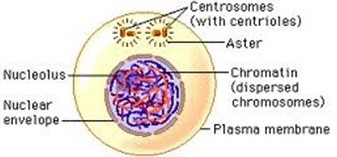
2.
PROPHASE
- In this stage centrioles separate and migrate to opposite cell’s poles.
- Chromosomes become visible, thicken and shorten
- Each chromosome divides into two along its length except at the centromere. Chromosomes now called chromatids.
- The nucleus membrane and nucleolus gradually disappears.
-
A network of fibres starts to form
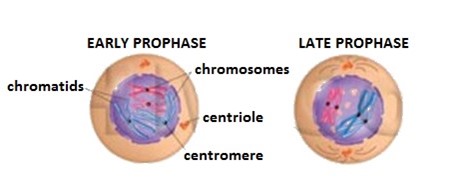
3. METAPHASE
– The chromatids move to the centre of cell.
– The chromatids become arranged and attached to spindle fibres by centromeres.
– The chromatids draw apart at the centromere region
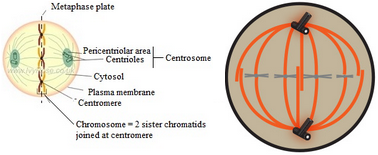
edu.uptymez.com
4. ANAPHASE
– In this stage, after the sister chromatids divide at centromere, they migrate to the apposite poles of the spindle, the centromere leading it.
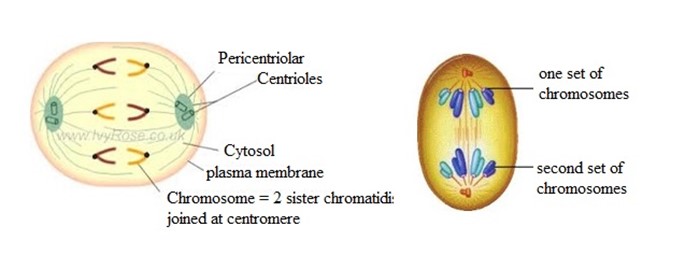
– Chromatids reach their destination towards the poles of the spindle. Now chromatids are called chromosome
-
5. TELOPHASE
– In early telophase, the spindle fibres disappear,
– A nuclear membrane is formed enclosing the newly formed chromosomes.
– At this stage, in animal cells, the cell starts to constrict across the middle into two new cells.
– In plant cells a cell wall is formed across the middle of the cell

edu.uptymez.com
CYTOKINESIS
This is the division of the cytoplasm. It is through the formation of a new cell wall in plant cell or the constriction of the animal cell.
SIGNIFICANCE OF MITOSIS
- It is the basis of asexual reproduction
- It maintains the diploid state of the organism
- It is the basis of growth i.e it brings about growth in terms of increase in number of cells.
-
It help to recovery of dead worn out cell
edu.uptymez.com
DIFFERENCE BETWEEN MEIOSIS AND MITOSIS
|
SN |
MEIOSIS |
MITOSIS |
|
|
Occurs in reproductive cells to form gametes |
Occurs in body cells during grow and tissue repair (somatic cell) |
|
|
Gametes fuse to form a zygote |
New cells do not fuse to form a zygote |
|
|
Variation occurs through chromosomes recombination |
No variation, all are like parents. |
|
|
Takes place in two phases to complete |
Take place in one phase to complete a successful cell division |
|
|
New formed daughter cells are in haploid state |
Newly formed daughter cells are in diploid state |
|
|
Results in four daughter cells (haploid) |
Result in to two diploid daughter cells |
edu.uptymez.com
